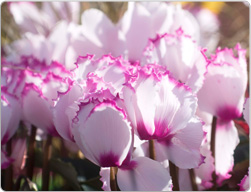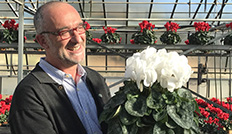 Professional area | Diseases factsheet | Fungi | Phyllosticta cyclaminis
Professional area | Diseases factsheet | Fungi | Phyllosticta cyclaminis
Phyllosticta are fungi which cause leaf staining.
These stains have the characteristic of being almost always oriented along the veins of the leaf.
Cool and damp conditions are conducive to this infection.
Conventional fungicides can be used with good results.
Phyllosticta are fungi of the family Phomaceae, in the order Phomales and the class Adelomycetes. The mycelium is filamentous and septate (with simple compartments). They reproduce only asexually, by forming conidia.
The Perfect Fungus form of Phyllosticta is the genus Guignardia (in the Sphaeriaceae family, order Spaeropsidales, class Pyrenomycetes of the sub-division Ascomycotina).
Phyllosticta are parasites of flowering plants, and are considered balanced parasites. They are the main cause of stained patches of the leaves.
Phyllosticta cyclaminis is the one that causes these symptoms on cyclamen.
Large stained patches, with well-defined borders, appear on the leaves. They are light in colour and their edges are fairly irregular; they are particular in being almost always oriented along the veins. Cool, damp conditions are highly favourable to this disease, which especially attacks plant debris. Such debris is then a main source of first infection.
After the stains, black dots appear in their centres; these are in fact the fruiting bodies of the fungus. As they grow, the fungus spreads by means of conidia.
The constant development of the regulations and homologations of phytosanitary treatment products, and the differences in regulations according to each country make it impossible for us to include updated information on homologations. Each producer will have to contact his local plant protection bureau to obtain the latest updates concerning the regulations and use of phytosanitary products. We strongly advise testing beforehand on a plant sample in order to measure the chemical’s activity (establishing the dose) and any effect on the plant (plant poisoning).
This advice sheet is based on the methods used at the SCEA at Montourey (Fréjus, France). These procedures may need some modification to adapt them to other climatic situations. Before starting to grow cyclamen there needs to be a review of precautions against pests and diseases. We must point out that our advice and suggestions are offered for information purposes and therefore cannot include any guarantee of specific results; it is a good idea to carry out trials beforehand.

2565, rue de Montourey
83600 Fréjus - France
International telephone : +33 (0)4 94 19 73 04
Switchboard : + 33 (0)4 94 19 73 00
Fax : +33 (0)4 94 19 73 19

